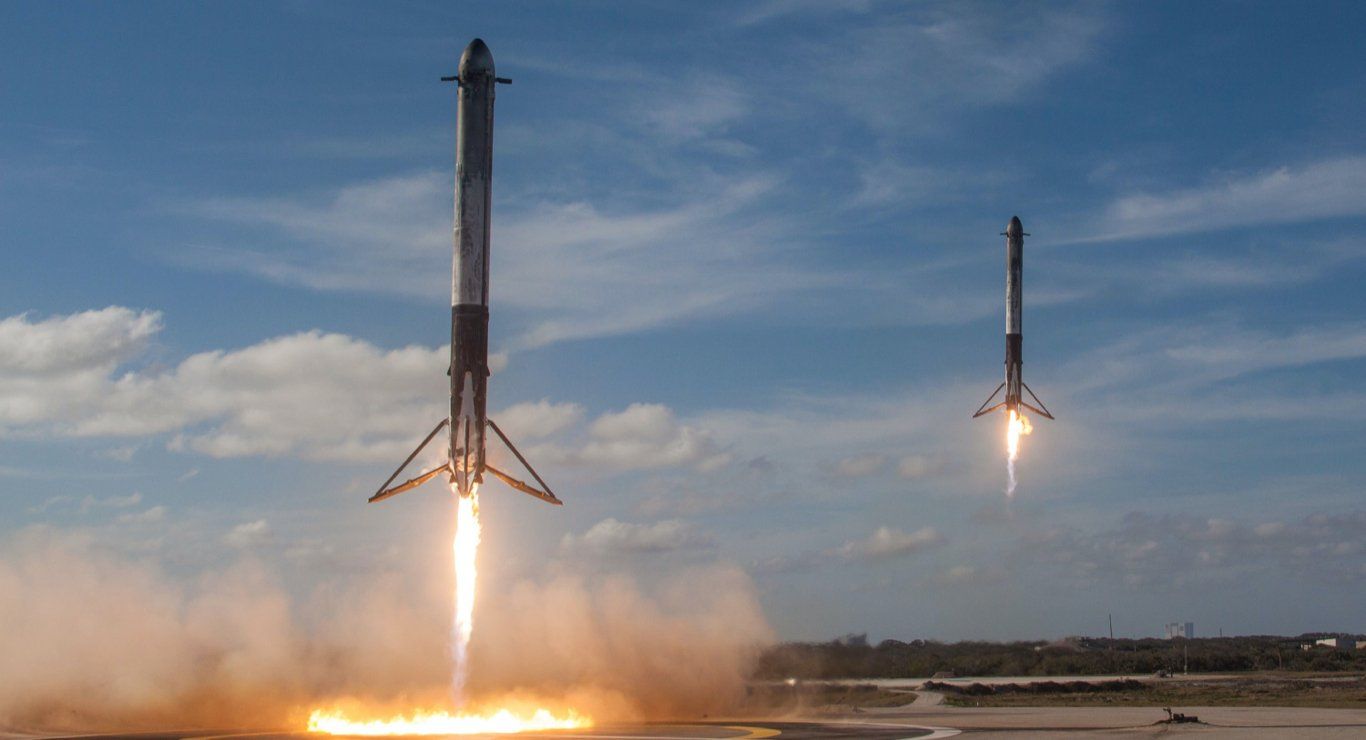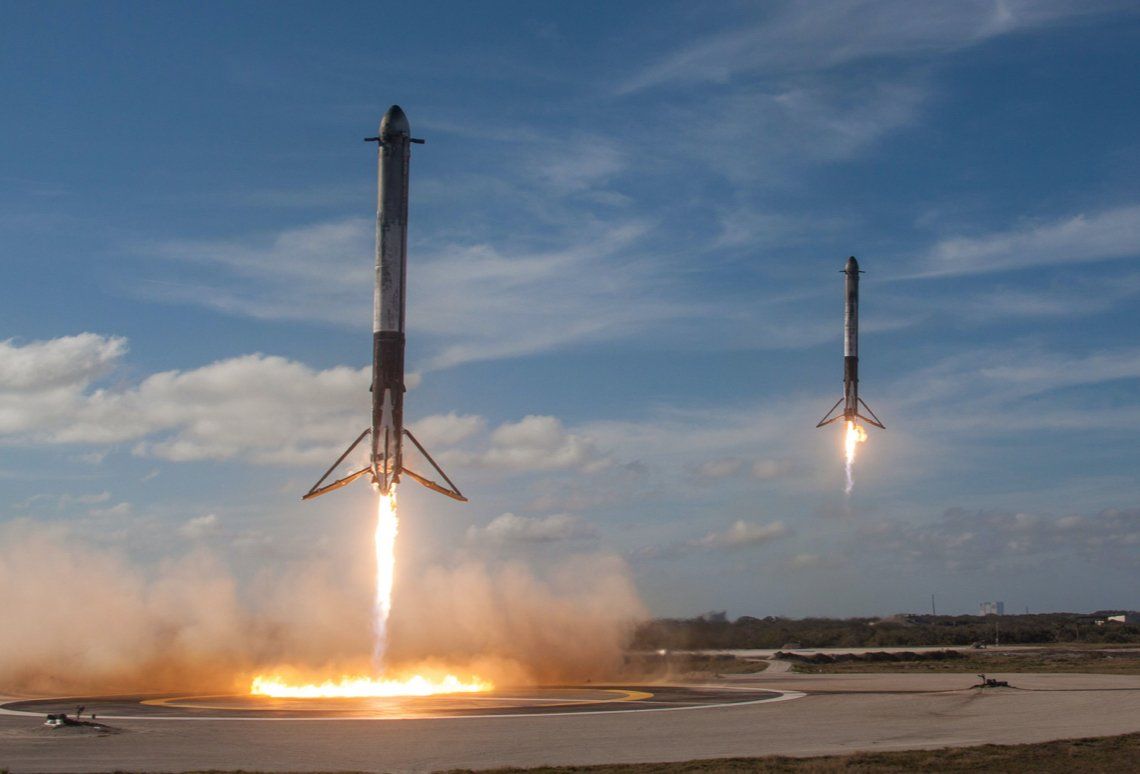2-6 May 2022
New tech paving the way, better news for NASA, and Ukraine invasion continues to influence space activity

SpaceX had their busiest month yet in April (Image: Unsplash)
The private sector has again this week has led the way for commercial space launch capabilities, with even a new space hotel in the making. China are still on course to achieve their goals, and NASA have received some more positive news. But sadly we are still witnessing the fallout from the Ukraine invasion, affecting Europe and indeed global space ambitions.
China and SpaceX storming ahead, and what next for ISS? (Could space take Russia’s place?)
China made a series of announcements last week, and this week involved their new Tiangong station, on course for completion this year. International cooperation and commercialisation are planned for the station, and it will be interesting how this will influence the reforging of international alliances, especially concerning Russia and their announcement that they will end cooperation on ISS. Russia’s Roscosmos made the announcement, giving a years notice to their partners. Upon hearing this news we can’t help but immediately think of SpaceX and Musk’s plan to step in and provide the technology to keep ISS in orbit (a job currently managed by Russia).
SpaceX have had yet another successful week, after having their busiest month yet in April. A SpaceX engineer also outlined the capabilities of their upcoming Starship and hinted to NASA that they should consider its significantly increased payload capacity (100 metric tons) for lunar missions. This could have a significant impact on e.g capabilities for in-situ resource manufacturing and building permanent lunar structures.
Europe remains ambitious, but Ukraine conflict still having effect
Sadly, the invasion of Ukraine continues to impact international cooperation in space, and Europe is feeling the effects. As the ESA and Russia will now not be working together on the ExoMars project, it is now looking like it will be pushed back to 2028. However, in more positive news, the ESA is now take shape with its Moonlight programme, a project aimed at building navigation and telecommunications for the Moon.
More positive news for NASA and Boeing, and new hope for Artemis-1
NASA seems to have had more luck this week, and it appears Artemis-1 could be on track for a June launch rehearsal. NASA chief Bill Nelson has also announced that they will now be looking to cut costs and increase competition in a new “fixed cost” contracting policy. They have also been testing systems to bring back rock samples from the Mars perseverance rover by 2033, and their asteroid probe “Psyche” has arrived at the Kennedy Centre, and still on course from launch in August. To top this off, Boeing’s Starliner module is also on course for a May 19th launch, in much better news for company.
Private sector again taking big strides
The private sector was of course also making headlines as well this week, with Rocket Lab carrying out their first demonstration of catching their reusable rockets using a helicopter and Sierra Space releasing images of their soon to be competed Dream Chaser space vehicle. Furthermore, launch company Stratolaunch have also tested their enormous airplane (the world’s largest by wingspan), which will be used for mid-air rocket launch capabilities, and plans are also in place for the first “space hotel”, which could apparently open as early as 2025, planned by US company Orbital Assembly.
Lastly, Scientists in China claim that lunar dust has the compounds to convert carbon dioxide into oxygen, which could be a big move forwards for resource extraction and facilitating lunar exploration, and beyond. Another busy week. Another busy week.
Want to keep up to date? Follow ANASDA
External Links
This Week
*News articles posted here are not property of ANASDA GmbH and belong to their respected owners. Postings here are external links only.
Our future in space

SpaceX had their busiest month yet in April (Image: Unsplash)
2 - 6 May, 2022
New tech paving the way, better news for NASA, and Ukraine continues to influence space
The private sector has again this week has led the way for commercial space launch capabilities, with even a new space hotel in the making. China are still on course to achieve their goals, and NASA have received some more positive news. But sadly we are still witnessing the fallout from the Ukraine invasion, affecting Europe and indeed global space ambitions.
China and SpaceX storming ahead, and what next for ISS? (Could space take Russia’s place?)
China made a series of announcements last week, and this week involved their new Tiangong station, on course for completion this year. International cooperation and commercialisation are planned for the station, and it will be interesting how this will influence the reforging of international alliances, especially concerning Russia and their announcement that they will end cooperation on ISS. Russia’s Roscosmos made the announcement, giving a years notice to their partners. Upon hearing this news we can’t help but immediately think of SpaceX and Musk’s plan to step in and provide the technology to keep ISS in orbit (a job currently managed by Russia).
SpaceX have had yet another successful week, after having their busiest month yet in April. A SpaceX engineer also outlined the capabilities of their upcoming Starship and hinted to NASA that they should consider its significantly increased payload capacity (100 metric tons) for lunar missions. This could have a significant impact on e.g capabilities for in-situ resource manufacturing and building permanent lunar structures.
Europe remains ambitious, but Ukraine conflict still having effect
ISadly, the invasion of Ukraine continues to impact international cooperation in space, and Europe is feeling the effects. As the ESA and Russia will now not be working together on the ExoMars project, it is now looking like it will be pushed back to 2028. However, in more positive news, the ESA is now take shape with its Moonlight programme, a project aimed at building navigation and telecommunications for the Moon.
More positive news for NASA and Boeing, and new hope for Artemis-1
NASA seems to have had more luck this week, and it appears Artemis-1 could be on track for a June launch rehearsal. NASA chief Bill Nelson has also announced that they will now be looking to cut costs and increase competition in a new “fixed cost” contracting policy. They have also been testing systems to bring back rock samples from the Mars perseverance rover by 2033, and their asteroid probe “Psyche” has arrived at the Kennedy Centre, and still on course from launch in August. To top this off, Boeing’s Starliner module is also on course for a May 19th launch, in much better news for company.
Private sector again taking big strides
The private sector was of course also making headlines as well this week, with Rocket Lab carrying out their first demonstration of catching their reusable rockets using a helicopter and Sierra Space releasing images of their soon to be competed Dream Chaser space vehicle. Furthermore, launch company Stratolaunch have also tested their enormous airplane (the world’s largest by wingspan), which will be used for mid-air rocket launch capabilities, and plans are also in place for the first “space hotel”, which could apparently open as early as 2025, planned by US company Orbital Assembly.
Lastly, Scientists in China claim that lunar dust has the compounds to convert carbon dioxide into oxygen, which could be a big move forwards for resource extraction and facilitating lunar exploration, and beyond. Another busy week.
Want to keep up to date? Follow ANASDA
External Links
This Week
*News articles posted here are not property of ANASDA GmbH and belong to their respected owners. Postings here are external links only.
2-6 May 2022
New tech paving the way, better news for NASA, and Ukraine invasion continues to influence space activity

SpaceX had their busiest month yet in April (Image: Unsplash)
The private sector has again this week has led the way for commercial space launch capabilities, with even a new space hotel in the making. China are still on course to achieve their goals, and NASA have received some more positive news. But sadly we are still witnessing the fallout from the Ukraine invasion, affecting Europe and indeed global space ambitions.
China and SpaceX storming ahead, and what next for ISS? (Could space take Russia’s place?)
China made a series of announcements last week, and this week involved their new Tiangong station, on course for completion this year. International cooperation and commercialisation are planned for the station, and it will be interesting how this will influence the reforging of international alliances, especially concerning Russia and their announcement that they will end cooperation on ISS. Russia’s Roscosmos made the announcement, giving a years notice to their partners. Upon hearing this news we can’t help but immediately think of SpaceX and Musk’s plan to step in and provide the technology to keep ISS in orbit (a job currently managed by Russia).
SpaceX have had yet another successful week, after having their busiest month yet in April. A SpaceX engineer also outlined the capabilities of their upcoming Starship and hinted to NASA that they should consider its significantly increased payload capacity (100 metric tons) for lunar missions. This could have a significant impact on e.g capabilities for in-situ resource manufacturing and building permanent lunar structures.
Europe remains ambitious, but Ukraine conflict still having effect
Sadly, the invasion of Ukraine continues to impact international cooperation in space, and Europe is feeling the effects. As the ESA and Russia will now not be working together on the ExoMars project, it is now looking like it will be pushed back to 2028. However, in more positive news, the ESA is now take shape with its Moonlight programme, a project aimed at building navigation and telecommunications for the Moon.
UMore positive news for NASA and Boeing, and new hope for Artemis-1
NASA seems to have had more luck this week, and it appears Artemis-1 could be on track for a June launch rehearsal. NASA chief Bill Nelson has also announced that they will now be looking to cut costs and increase competition in a new “fixed cost” contracting policy. They have also been testing systems to bring back rock samples from the Mars perseverance rover by 2033, and their asteroid probe “Psyche” has arrived at the Kennedy Centre, and still on course from launch in August. To top this off, Boeing’s Starliner module is also on course for a May 19th launch, in much better news for company.
Private sector again taking big strides
The private sector was of course also making headlines as well this week, with Rocket Lab carrying out their first demonstration of catching their reusable rockets using a helicopter and Sierra Space releasing images of their soon to be competed Dream Chaser space vehicle. Furthermore, launch company Stratolaunch have also tested their enormous airplane (the world’s largest by wingspan), which will be used for mid-air rocket launch capabilities, and plans are also in place for the first “space hotel”, which could apparently open as early as 2025, planned by US company Orbital Assembly.
Lastly, Scientists in China claim that lunar dust has the compounds to convert carbon dioxide into oxygen, which could be a big move forwards for resource extraction and facilitating lunar exploration, and beyond. Another busy week. Another busy week.
Want to keep up to date? Follow ANASDA
External Links
This Week
*News articles posted here are not property of ANASDA GmbH and belong to their respected owners. Postings here are external links only.






















